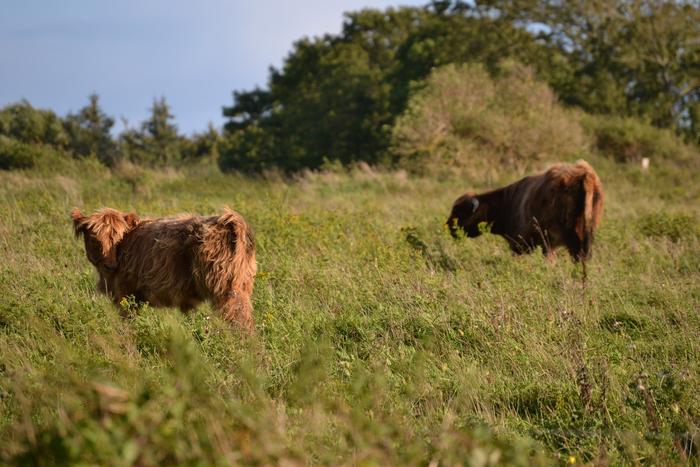The grazing of both domestic and wild animals is shaping landscapes across Europe. It can also contribute to multiple ecosystem services, such as providing habitat for biodiversity. Grazing systems with lower densities of animals and with minimal and only targeted applications of deworming and other medicinal treatments offer benefits for local biodiversity protection and various ecosystem services. However, this type of land management also poses a range of challenges, leading to a constant decline in the number of land users engaged in low-intensity grazing. A team of researchers led by iDiv, UL, and UFZ set out to investigate these challenges and potential interventions in eight European case studies. Between 2019 and 2021, they conducted 74 face-to-face interviews with farmers, landowners, livestock owners, and managers of a rewilding area with semi-wild herbivores, like wild ponies or semi-wild cattle.

Credit: A. Pohl
The grazing of both domestic and wild animals is shaping landscapes across Europe. It can also contribute to multiple ecosystem services, such as providing habitat for biodiversity. Grazing systems with lower densities of animals and with minimal and only targeted applications of deworming and other medicinal treatments offer benefits for local biodiversity protection and various ecosystem services. However, this type of land management also poses a range of challenges, leading to a constant decline in the number of land users engaged in low-intensity grazing. A team of researchers led by iDiv, UL, and UFZ set out to investigate these challenges and potential interventions in eight European case studies. Between 2019 and 2021, they conducted 74 face-to-face interviews with farmers, landowners, livestock owners, and managers of a rewilding area with semi-wild herbivores, like wild ponies or semi-wild cattle.
Land users rely on subsidies, but money is not everything
The researchers focused on the motivation and challenges driving decision-making among all land users engaged in low-intensity grazing practices. This was despite economic considerations becoming increasingly important as land users’ revenue-generating activities are no longer sufficient to cover the rising cost of equipment, rent, and taxes.
“Money is not everything. Many of the land users we interviewed practice this type of grazing management because they think it is good, not out of economic motivation”, says first author Dr Julia Rouet-Leduc. Rouet-Leduc led the project as a former doctoral researcher at iDiv and UL and is now a postdoctoral researcher at the Stockholm Resilience Centre. Caring for nature and, in some cases, also the desire to maintain traditional agricultural practices were important aspects of the land users’ motivation. For example, a land user working with wild ponies in Galicia (Spain) shared: “The main reason for the maintenance of this system is that people … love the ponies; they ‘have a fever’, and this tradition runs very deeply in their hearts.”
The researchers found that many land users struggle with rules and regulations that are incompatible with low-intensity grazing management. For example, rules to mark or tag livestock – an extremely challenging task when animals are allowed to graze freely in large areas – were perceived as limiting. Land users also felt that the policies in place, especially the Common Agricultural Policy of the European Commission (CAP), were holding back nature-friendly and sustainable practices. For example, a land user in Romania noted that farmers were required to remove scrubs from their pastures or they would otherwise not be eligible for subsidies or even have to pay penalties. However, scrubs have important ecosystem functions, such as providing shade in the summer and as an additional food resource in the winter. In general, the CAP was perceived as too restrictive, and many land users chose not to apply for subsidies at all. “By not applying for CAP support, we have the freedom to really see what suits the local ecosystem”, a Belgian land user stated.
Rural exodus is putting traditional labour at risk
The interviews also showed that many land users struggle with socio-economic changes in the countryside. The so-called ‘Rural Exodus’ is leading to a lack of workforce, while physical work is still very much needed, especially for work with cattle or horses. “The next generation does not want to farm because it is too hard, too much work”, a land user from Lithuania said. “They usually move abroad and choose easier career options’.’
“The CAP could support farmers in High Nature Value farming regions and put incentives in place to preserve or restore extensive grazing systems,” senior author Dr Guy Pe’er, a senior researcher at UFZ and iDiv, suggests. “It’s not a lack of budgets but rather the lack of ambition to support sustainable farming.”
More flexibility and improved market access needed
The researchers used the interviews to derive and suggest interventions to encourage better grazing practices. “What is needed is more flexibility for land users”, Rouet-Leduc says. “Current policies are, for the most part, not encouraging such practices, and particularly not offering a level playing field for land users.” While the EU’s CAP offers important economic support, it also drives counter-productive management due to problematic requirements, she adds. Additional financial incentives could improve the support for more sustainable grazing management, according to the study’s authors. Especially in areas where land has been abandoned, there can be opportunities for rewilding large herbivores, which ultimately provide multiple ecosystem services. However, such systems require flexibility since they differ from management approaches with domestic animals.
The researchers also call for better labelling and certification for environmentally friendly grazing practices to increase public support and to help develop markets for such products. Some of the interviewed land users felt that market access could be improved by supporting direct marketing, for example, via farm shops.
“There are clearly real challenges for farmers, and they are not easy to overcome”, Pe’er explains in light of ongoing farmers’ demonstrations in countries like Germany, Poland, and Italy. “But removing environmental standards will not help land users. They need a package that includes an ambitious CAP reform, providing real support for farmers who need it to be more sustainable; the Nature Restoration Law to improve the standards of good management; and a framework for sustainable food systems to improve the market options for sustainable farming.”
This study was, among others, funded by the German Research Foundation (DFG; FZT-118) and as part of GRAZELIFE, a LIFE Preparatory Project on request of the European Commission to assess the impact of different grazing systems on ecosystem service provision (LIFE18PRE/NL002).
Kati Kietzmann
Journal
Land Use Policy
DOI
10.1016/j.landusepol.2024.107146
Method of Research
Case study
Subject of Research
Not applicable
Article Title
Exploring the motivation and challenges for land-users engaged in sustainable grazing in Europe
Article Publication Date
8-Apr-2024




